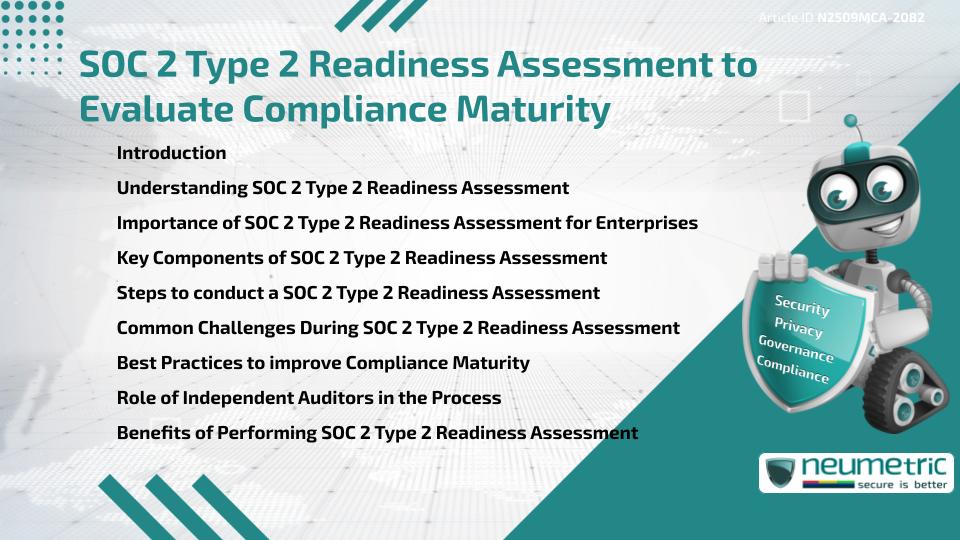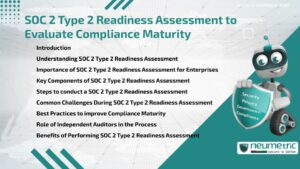Table of Contents
ToggleIntroduction
The SOC 2 type 2 Readiness Assessment is a structured evaluation that Organisations use to measure their compliance maturity before undergoing an official SOC 2 Type 2 Audit. It helps enterprises identify control gaps, strengthen security processes & prepare for independent auditor reviews. By conducting this Assessment, businesses ensure that their systems meet Trust Service Criteria & reduce the Risks of Audit delays or failures. This article explains the importance, components, challenges & benefits of readiness assessments while offering Best Practices to enhance compliance maturity.
Understanding SOC 2 Type 2 Readiness Assessment
A SOC 2 type 2 Readiness Assessment is essentially a pre-Audit check. Unlike the official SOC 2 Type 2 Audit, which validates operational effectiveness of controls over time, the Readiness Assessment is an internal exercise to gauge preparedness.
It focuses on evaluating Security Controls, documentation, Risk Management practices & Employee adherence to Policies. This proactive step helps enterprises address weaknesses before Auditors examine their systems.
Importance of SOC 2 Type 2 Readiness Assessment for Enterprises
Conducting a SOC 2 type 2 Readiness Assessment is vital for Organisations that handle sensitive Customer Data. It offers several benefits:
- Identifies Security Gaps early.
- Reduces chances of non-compliance findings during the official Audit.
- Builds Stakeholder confidence by showing proactive commitment.
- Enhances overall enterprise Data Protection maturity.
In industries such as Finance, Healthcare & cloud services, this Assessment often becomes a Standard requirement for maintaining trust.
Key Components of SOC 2 Type 2 Readiness Assessment
A strong SOC 2 type 2 Readiness Assessment covers five (5) Trust Service Criteria:
- Security: Ensuring systems are protected from unauthorized access.
- Availability: Confirming that data & systems are accessible as promised.
- Processing Integrity: Validating that processes deliver accurate & reliable outcomes.
- Confidentiality: Restricting Sensitive Data access to authorized users.
- Privacy: Safeguarding Personal Information under applicable laws.
Each component must be tested against the enterprise’s Policies, controls & technical safeguards.
Steps to conduct a SOC 2 Type 2 Readiness Assessment
Organisations can follow these practical steps for a successful SOC 2 type 2 Readiness Assessment:
- Define scope – Identify systems, processes & criteria relevant to the Audit.
- Evaluate current controls – Assess whether Policies & technologies align with requirements.
- Identify gaps – Highlight areas that fall short of Trust Service Criteria.
- Develop remediation plan – prioritise actions to close identified gaps.
- Conduct mock Audit – Simulate Audit conditions to test readiness.
- Engage Stakeholders – Ensure leadership & Employees understand their roles.
By following these steps, enterprises can approach the official Audit with greater confidence.
Common Challenges During SOC 2 Type 2 Readiness Assessment
A SOC 2 type 2 Readiness Assessment can be demanding & enterprises may face obstacles such as:
- Resource limitations – Budget, tools or personnel constraints.
- Complex Evidence collection – Difficulty in documenting proof of controls.
- Misaligned scope – Choosing either too broad or too narrow a focus.
- Resistance to change – Employees may struggle to adapt to new compliance measures.
Understanding these challenges allows Organisations to address them proactively.
Best Practices to improve Compliance Maturity
To maximize effectiveness of a SOC 2 type 2 Readiness Assessment, enterprises should:
- Establish a compliance culture through ongoing training.
- Use automation tools for monitoring & Evidence gathering.
- Maintain clear documentation of processes & controls.
- Involve cross-functional teams, including IT, legal & operations.
- Perform regular internal reviews to detect weaknesses early.
These practices ensure that compliance maturity grows consistently across the Organisation.
Role of Independent Auditors in the Process
Although the Readiness Assessment is primarily internal, many Organisations engage independent Auditors for advisory input. External experts can provide guidance, validate findings & highlight potential Risks. While they do not issue an official SOC 2 Type 2 report during this stage, their involvement increases the accuracy of the Assessment.
Benefits of Performing SOC 2 Type 2 Readiness Assessment
Enterprises that conduct a SOC 2 type 2 Readiness Assessment gain advantages such as:
- Fewer surprises during the official Audit.
- Improved alignment of business processes with security standards.
- Strengthened trust among clients & regulators.
- Reduced operational disruptions during compliance reviews.
- Enhanced long-term resilience against Threats.
These benefits demonstrate the importance of readiness assessments as part of a holistic compliance strategy.
Conclusion
A SOC 2 type 2 Readiness Assessment enables enterprises to evaluate compliance maturity, strengthen internal controls & prepare effectively for official audits. While challenges exist, the process enhances organisational resilience, builds Client trust & ensures smoother Certification journeys.
Takeaways
- SOC 2 Type 2 readiness assessments act as pre-Audit evaluations.
- They focus on security, availability, processing integrity, confidentiality & Privacy.
- Steps include Defining Scope, identifying gaps & conducting mock audits.
- Challenges involve resources, Evidence collection & cultural resistance.
- Best Practices & auditor involvement improve compliance maturity.
FAQ
What is the purpose of a SOC 2 type 2 Readiness Assessment?
Its purpose is to evaluate compliance maturity, identify gaps & prepare Organisations for an official SOC 2 Type 2 Audit.
How long does a Readiness Assessment take?
It usually takes several weeks to a few months, depending on scope & organisational readiness.
Do all Organisations need a SOC 2 type 2 Readiness Assessment?
Not all, but enterprises handling sensitive Customer Data benefit greatly from conducting one.
Can a Readiness Assessment replace an official Audit?
No, it is only a preparatory step. An official SOC 2 Type 2 Audit must still be conducted by accredited auditors.
Who should be involved in the Readiness Assessment?
Key Stakeholders include IT teams, Compliance Officers, Legal teams & Executive leadership.
What happens if gaps are found during the Assessment?
Organisations create a remediation plan to address weaknesses before undergoing the official Audit.
Is a Readiness Assessment mandatory?
It is not mandatory but strongly recommended for smoother compliance outcomes.
Need help for Security, Privacy, Governance & VAPT?
Neumetric provides organisations the necessary help to achieve their Cybersecurity, Compliance, Governance, Privacy, Certifications & Pentesting needs.
Organisations & Businesses, specifically those which provide SaaS & AI Solutions in the Fintech, BFSI & other regulated sectors, usually need a Cybersecurity Partner for meeting & maintaining the ongoing Security & Privacy needs & requirements of their Enterprise Clients & Privacy conscious Customers.
SOC 2, ISO 27001, ISO 42001, NIST, HIPAA, HECVAT, EU GDPR are some of the Frameworks that are served by Fusion – a SaaS, multimodular, multitenant, centralised, automated, Cybersecurity & Compliance Management system.
Neumetric also provides Expert Services for technical security which covers VAPT for Web Applications, APIs, iOS & Android Mobile Apps, Security Testing for AWS & other Cloud Environments & Cloud Infrastructure & other similar scopes.
Reach out to us by Email or filling out the Contact Form…





